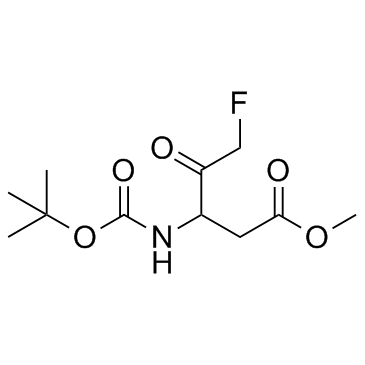All AbMole products are for research use only, cannot be used for human consumption.

In vitro: Apoptosis is a pathway of cell death orchestrated by a family of proteases called caspases. Boc-D-fmk inhibits TNFα-stimulated reactive oxygen species (ROS) generation. Boc-D-FMK inhibits apoptosis stimulated by TNF-α with an IC50 of 39 µM. BocD-fmk at 50 µM prevents genistein-induced apoptosis of p815 cells. Confocal microscopy shows that the release of mitochondrial apoptotic factors is inhibited by BocD-fmk. In vivo: Boc-D-FMK-fmk effectively attenuates the hepatocyte apoptosis in bile duct-ligated rats and may improve the survival rates after endotoxin challenge. A single injection of Boc-D-FMK results in longterm protection of MNs against root avulsion-induced death for more than 8 weeks and the Boc-D-FMK-treated MNs are able to regenerate their axons into an implanted PN graft and reinnervate the target muscle.
| Cell Experiment | |
|---|---|
| Cell lines | Neutrophils |
| Preparation method | Neutrophils (11.1 × 10^6 cells/mL) were cultured for 30 minutes in the presence or absence of 0.03-300 μM z-VAD-fmk or Boc-D-fmk before addition of TNFα (200 U/mL). Cells (100 μL) were added to a microtiter plate followed by an equal volume of lucigenin (0.25 mM for extracellular ROS release) or luminol (1 mM for intra- and extracellular ROS release). |
| Concentrations | 3-300 μM |
| Incubation time | 30 min |
| Animal Experiment | |
|---|---|
| Animal models | Male Sprague–Dawley rats |
| Formulation | DMSO |
| Dosages | 1.5 mg/kg |
| Administration | i.v. |
| Molecular Weight | 263.26 |
| Formula | C11H18FNO5 |
| CAS Number | 634911-80-1 |
| Solubility (25°C) | 125 mg/mL in DMSO |
| Storage |
Powder -20°C 3 years ; 4°C 2 years In solvent -80°C 6 months ; -20°C 1 month |
| Related Caspase Products |
|---|
| Z-VAD
Z-VAD is a competitive, irreversible pan-caspase inhibitor. Z-VAD inhibits all 10 caspases, except for caspase-2 which is only weakly inhibited. Z-VAD decreases radiation-induced apoptosis. |
| PEAQX
PEAQX (NVP-AAM077) is an orally active and selective NMDA antagonist, with IC50 values of 270 nM and 29.6 μM for hNMDAR 1A/2A and hNMDAR 1A/2B, respectively. |
| MMPSI
MMPSI is a potent and selective small molecule caspase 3 and caspase 7 inhibitor with an IC50 of 1.7 μM for human caspase-3. |
| Ivachtin
Ivachtin (Caspase-3 Inhibitor VII; compound 7a) is a nonpeptide, noncompetitive and reversibl caspase-3 inhibitor with an IC50 of 23 nM. |
| VMY-1-103
VMY-1-103 is an inhibitor for cyclin/Cdk complex, that arrests the cell cycle at G1 phase. |
All AbMole products are for research use only, cannot be used for human consumption or veterinary use. We do not provide products or services to individuals. Please comply with the intended use and do not use AbMole products for any other purpose.


Products are for research use only. Not for human use. We do not sell to patients.
© Copyright 2010-2024 AbMole BioScience. All Rights Reserved.
